Native Art Fellowship
The Wyoming Arts Council introduced the Native Art Fellowship in 2021 as part of its on-going effort to increase support and recognition of Wyoming’s rich cultural arts and traditions.
About the Native Art Fellowship
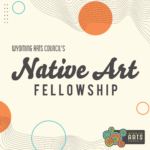 The Native Art Fellowship is a $5,000 unrestricted award of merit, based on the artist’s portfolio, honoring the work of Native artists based within Wyoming. Recipients of the Native Art Fellowship will also be given support to find a venue to showcase their work.
The Native Art Fellowship is a $5,000 unrestricted award of merit, based on the artist’s portfolio, honoring the work of Native artists based within Wyoming. Recipients of the Native Art Fellowship will also be given support to find a venue to showcase their work.
Artists working across any artistic discipline or medium (visual, literary, performing, folk & traditional, etc.) may apply. This fellowship is designed to raise the profiles of the highly talented Native artists in Wyoming and celebrate their artistry.
Applications are juried by noted Native artists outside the state. Two fellowships will be given this year. Jurors may also select honorable mentions.
2024 Native Art Fellowship Info
2024 Application Window: March 12 – May 15, 2024
ELIGIBILITY- Applicants must be an enrolled/citizen member or lineal descendant of a federally recognized tribe, a state recognized tribe, or be an Alaska Native or Native Hawaiian. If selected for the fellowship, you may be asked to provide a copy of a Tribal ID, letter of descendancy, or Certificate of Degree of Indian Blood (CDIB). If your tribe is not federally or state recognized you will be asked to provide more detailed information.
- Must be at least 18 years of age at time of application.
- Must not be a full-time student pursuing high school, college, or university art-related degrees.
- Must be a U.S. citizen or have legal resident status (evidence of U.S. citizenship, resident status and state residency may be required).
- May not be affiliated with the Wyoming Arts Council either as a board member or staff member, including their families, whether full-time, part-time or contractual.
- May not be an employee of the Department of State Parks and Cultural Resources.
- Must be a Wyoming resident, living in the state for at least 10 months of the year.
- May receive a total of two fellowship awards in your lifetime.
- You may choose to be automatically considered for the WAC fellowships in Creative Writing, Visual Arts, and Performing Arts, but you can only receive one Fellowship per year.
- You may enter the competition only once by the deadline.
WHAT IF YOU WIN AN AWARD?
- You’ll receive $5,000 up front.
- You’ll sign a contract that verifies you’re eligible to receive this award.
- You’ll need to supply a bio and a photograph for publicity.
- The Arts Council will work with you to find an appropriate venue or showcase to publicly share your work.
- You will retain all rights to this work and the work you produce during the grant period.
- You must create an impact statement, due August 31, 2025, sharing how this award helped you and what you accomplished during the year you received it.
- You may be asked to provide a copy of a Tribal ID, letter of descendancy, or Certificate of Degree of Indian Blood (CDIB). If your tribe is not federally or state recognized you will be asked to provide more detailed information.
SUBMISSION GUIDELINES
- Your name must not appear anywhere on your application.
- Do not send supplementary materials (letters, resumes, etc.)
- You may submit up to 10 work samples. Samples can be a combination of multiple art forms. Image, video, audio, and document files will be accepted.
- If submitting a writing sample, you may only upload ONE manuscript, up to 25 pages in length, typed, double-spaced using a 12-point standard font. If submitting poetry, only one poem is allowed per page and the double-spaced requirement is waived. For a book excerpt, you may provide a synopsis, but it will be included in the 25-page limit. You may submit more than one piece of writing, as long as you don’t exceed the 25-page limit. Pages must be numbered; include title of work and page number on each page.
- If submitting performance-based work, you may submit original works or performances of other works (not original). Fellowships are awarded to an individual; however work samples of group performances will be accepted for demonstrative purposes as long as the individual applicant is clearly identified in the description.
- Other work samples can include: experimental (conceptual/new media), graphic (printmaking/book arts), painting, sculpture, installation, photography (includes experimental, color, black & white, photocopy and computer), clay, fiber, glass, leather, metal, paper, plastic, wood, mixed media, film or video, beadwork, quillwork, regalia, ledger art, other traditional forms. Up to two images may be detail images, if appropriate. Jurors will only be required to watch up to 10 minutes of a film/video submission.
2024 Native Art Fellowship Recipients
Jackie Dorothy (Arapaho and Eastern Shoshone) | Writer, Podcaster, and Journalist
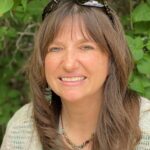 Jackie Dorothy (Thermopolis) is a distinguished writer, podcaster, and journalist with a deep expertise in Wyoming history. Her accolades include the Emerging Voices Award from the Society of Children’s Writers and Illustrators, the Wyoming Governor’s Journalist of the Year Against Impaired Driving, four Bronze Telly Awards, two Communicator Awards, and the title of Small Business Administrator Journalist of the Year for the Rocky Mountain Region.
Jackie Dorothy (Thermopolis) is a distinguished writer, podcaster, and journalist with a deep expertise in Wyoming history. Her accolades include the Emerging Voices Award from the Society of Children’s Writers and Illustrators, the Wyoming Governor’s Journalist of the Year Against Impaired Driving, four Bronze Telly Awards, two Communicator Awards, and the title of Small Business Administrator Journalist of the Year for the Rocky Mountain Region.
Her historical narrative podcast, “Pioneers of Outlaw Country,” can be found on most podcast platforms, and Jackie actively engages with her audience through a dedicated Facebook group. Recently, she joined Cowboy State Daily as a freelance reporter, where she continues to share compelling historical articles about Wyoming’s rich past. Always eager to challenge herself, Jackie remains dedicated to expanding her knowledge and sharing the stories of Wyoming.
Bruce Cook (Haida) | 2D Haida Art
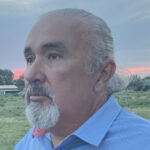 Bruce Cook is a Haida artist residing in Riverton, “I am driven to explore and innovate. The woods and natural materials I used that were once abundant in the Pacific Northwest are now scarce. This scarcity of resources has led to a creative drive that has been vital to my survival as a Haida artist in the high plains desert. My subject matter is Haida, both traditional and contemporary. As Native artists, we are capable of inhabiting both forms simultaneously. I am free to create without the confines of being bound to one or the other.”
Bruce Cook is a Haida artist residing in Riverton, “I am driven to explore and innovate. The woods and natural materials I used that were once abundant in the Pacific Northwest are now scarce. This scarcity of resources has led to a creative drive that has been vital to my survival as a Haida artist in the high plains desert. My subject matter is Haida, both traditional and contemporary. As Native artists, we are capable of inhabiting both forms simultaneously. I am free to create without the confines of being bound to one or the other.”
When talking about his art, Cook says “My favorite mediums are yellow cedar and fresh red alder. Their suppleness, delicacy, strength, and willingness to be transformed in both form and texture make them perfect mediums for exploring Haida art. However, since there is no longer a supply of yellow cedar and alder, my inspiration has now shifted to creating 2D Haida art on canvas. Using acrylic paints to create the designs, I explore the abstract use of the ovoid and U shapes to create the art of the Haida.”
“I have also been exploring my Arapaho side by creating ledger art as well as designs inspired by the beadwork of my Arapaho ancestors. This has led to interesting combinations of Haida and Arapaho designs.” Cook goes on to say, “Each day brings a new desire to practice the forms of those who have come before me and a push to innovate in the forms that are yet to come. This inspiration is my daily spirit to create.”
Meet the 2024 Jurors
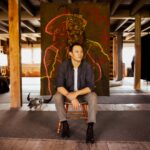 Ben Pease (b.1989) is a native Montanan artist of Tsitsistas and Apsáalooke descent. He is Newly-Made Lodge clan from the Valley of the Chiefs District on the Crow Indian Reservation. His educational background includes studies at Minot State University, Montana State University, and Little Big Horn College. Pease uses his work to seek understanding and perspective as an Indigenous person, as reflected in his diverse projects and collaborations. His work has been featured in major exhibitions at museums such as the Field Museum of Chicago and the New York Historical Society. His works have been collected worldwide and are represented in the permanent collections of institutions such as the Whitney Western Art Museum and the Plains Indian Museum at the Buffalo Bill Center of the West, Montana State University, and the Mulvane Art Museum.
Ben Pease (b.1989) is a native Montanan artist of Tsitsistas and Apsáalooke descent. He is Newly-Made Lodge clan from the Valley of the Chiefs District on the Crow Indian Reservation. His educational background includes studies at Minot State University, Montana State University, and Little Big Horn College. Pease uses his work to seek understanding and perspective as an Indigenous person, as reflected in his diverse projects and collaborations. His work has been featured in major exhibitions at museums such as the Field Museum of Chicago and the New York Historical Society. His works have been collected worldwide and are represented in the permanent collections of institutions such as the Whitney Western Art Museum and the Plains Indian Museum at the Buffalo Bill Center of the West, Montana State University, and the Mulvane Art Museum.
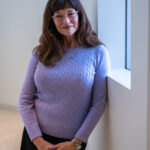 Dakota Hoska (Oglála Lakȟóta Nation, Pine Ridge, Wounded Knee) serves as the Associate Curator of Native Arts at the Denver Art Museum where she has been employed since 2019. Previously, she served as a Curatorial Research Assistant at the Minneapolis Institute of Art supporting the ground-breaking exhibition “Hearts of Our People: Native Women Artists.” Hoska completed her MA in Art History, focusing on Native American Art History, at the University of St. Thomas, St. Paul, MN (2019). She also completed two years of Dakhóta language at the University of Minnesota (2016) and received her BFA in Drawing and Painting from the Minneapolis College of Art and Design (2012). Dakota has participated in multiple curatorial programs such as the EPIC international curatorial exchange program sponsored by the Association of Art Museum Curators, the Otsego Summer Seminar sponsored by the Fenimore Art Museum, the Shakopee Mdewakanton Native American Museum Fellowship at the Minneapolis Institute of Art, and the American Indian Museum Fellowship at the Minnesota Historical Society. She currently serves on multiple national advisory councils and frequently writes about and presents on issues related to curating Native North American art collections.
Dakota Hoska (Oglála Lakȟóta Nation, Pine Ridge, Wounded Knee) serves as the Associate Curator of Native Arts at the Denver Art Museum where she has been employed since 2019. Previously, she served as a Curatorial Research Assistant at the Minneapolis Institute of Art supporting the ground-breaking exhibition “Hearts of Our People: Native Women Artists.” Hoska completed her MA in Art History, focusing on Native American Art History, at the University of St. Thomas, St. Paul, MN (2019). She also completed two years of Dakhóta language at the University of Minnesota (2016) and received her BFA in Drawing and Painting from the Minneapolis College of Art and Design (2012). Dakota has participated in multiple curatorial programs such as the EPIC international curatorial exchange program sponsored by the Association of Art Museum Curators, the Otsego Summer Seminar sponsored by the Fenimore Art Museum, the Shakopee Mdewakanton Native American Museum Fellowship at the Minneapolis Institute of Art, and the American Indian Museum Fellowship at the Minnesota Historical Society. She currently serves on multiple national advisory councils and frequently writes about and presents on issues related to curating Native North American art collections.
Previous Native Art Fellowship Recipients
2023 | Rose Pecos-SunRhodes (Ceramics), Taylar Dawn Stagner (Journalism & Creative Writing)
2022 | Christian Wallowing Bull, Talissa Abeyta
2021 | Colleen Friday
Contact Information
For more information on the Native Art Fellowship, contact Kimberly Mittelstadt at the Arts Council, 307-274-6673 or kimberly.mittelstadt@wyo.gov.
